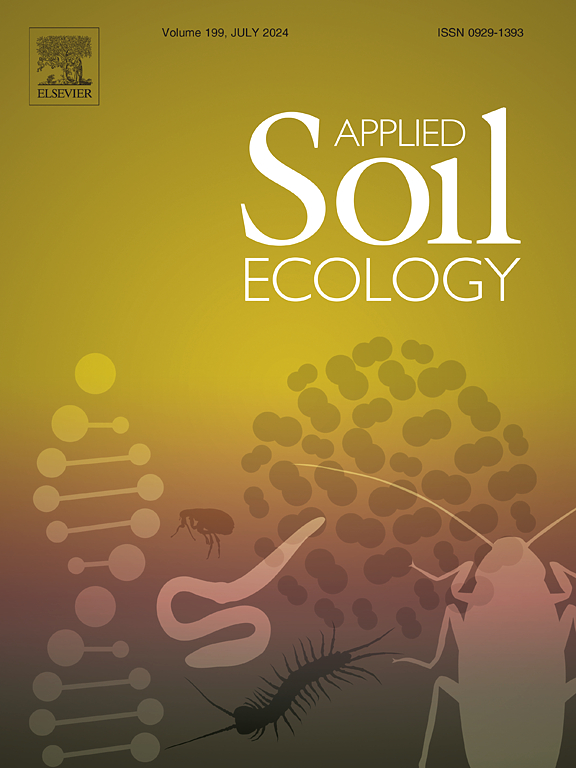在英格兰北部,一个家禽养殖场排放的氨驱动了沿着树木带的土壤生物地球化学和微生物群落的变化
IF 5
2区 农林科学
Q1 SOIL SCIENCE
引用次数: 0
摘要
在英国,87%的氨(NH3)排放来自农业,主要来自集中的点源,导致氮沉积浓度超标。可以在排放源周围种植树带(也称为防护林带),以拦截NH3并减少其漂移。本研究考察了大气NH3浓度如何影响英国坎布里亚郡一个家禽养殖场13年树龄的树木带下的土壤生物地球化学以及真菌和细菌群落的组成和丰富度。为了评估NH3浓度的影响,我们测量了树木的生长情况,并分析了在离家禽舍不同距离处收集的土壤样本。在最高NH3浓度下,土壤pH值下降13% (p <;0.001),我们检查的9种营养素中有6种显著下降(p <;NH3浓度最高时,林带土壤有机碳含量增加29% (p <;0.05)。土壤真菌和细菌的群落组成(基于ITS、LSU和16S扩增子测序)随NH3浓度的变化显著(p <;0.001),主要受土壤pH、磷酸盐、碳氮比和铵(外加细菌所需的硝酸盐)的影响。最高NH3浓度下,丛枝菌根真菌、腐养真菌和细菌的属丰富度分别降低了80%、9%和13% (p <;0.05)。总体而言,靠近家禽舍的NH3浓度越高,土壤化学成分和微生物群落组成就会发生显著变化,丰富度也会降低,这突出了在使用林带捕获排放时了解NH3对土壤生态的影响的重要性。本文章由计算机程序翻译,如有差异,请以英文原文为准。

Ammonia emissions from a poultry farm drive changes in soil biogeochemistry and microbial communities along a treebelt in northern England
Agriculture is responsible for 87 % of ammonia (NH3) emissions in the UK, mostly from concentrated point sources, contributing to the exceedance of critical nitrogen deposition concentrations. Treebelts (also known as shelterbelts) can be planted around emission sources to intercept NH3 and reduce its drift. This study examined how atmospheric NH3 concentration affects soil biogeochemistry, and the composition and richness of fungal and bacterial communities beneath a 13-year-old treebelt on a poultry farm in Cumbria, UK. We measured tree growth and analysed soil samples collected at varying distances from the poultry housing to evaluate the effect of NH3 concentration. Under the highest NH3 concentration, soil pH decreased by 13 % (p < 0.001), six out of the nine nutrients we examined decreased significantly (p < 0.05), while soil organic carbon was 29 % higher under the greatest NH3 concentration within the treebelt (p < 0.05). The community composition of soil fungi and bacteria (based on ITS, LSU, and 16S amplicon sequencing) changed significantly with NH3 concentration (p < 0.001), driven mainly by soil pH, phosphate, C/N ratio and ammonium (plus nitrate for bacteria). Genus richness of arbuscular mycorrhizal fungi, saprotrophic fungi, and bacteria were 80 %, 9 %, and 13 % lower respectively under the highest NH3 concentration (p < 0.05). Overall, higher NH3 concentrations closer to the poultry housing significantly altered soil chemistry and microbial community composition, and reduced richness, highlighting the importance of understanding NH₃ impacts on soil ecology when using treebelts to capture emissions.
求助全文
通过发布文献求助,成功后即可免费获取论文全文。
去求助
来源期刊

Applied Soil Ecology
农林科学-土壤科学
CiteScore
9.70
自引率
4.20%
发文量
363
审稿时长
5.3 months
期刊介绍:
Applied Soil Ecology addresses the role of soil organisms and their interactions in relation to: sustainability and productivity, nutrient cycling and other soil processes, the maintenance of soil functions, the impact of human activities on soil ecosystems and bio(techno)logical control of soil-inhabiting pests, diseases and weeds.
 求助内容:
求助内容: 应助结果提醒方式:
应助结果提醒方式:


